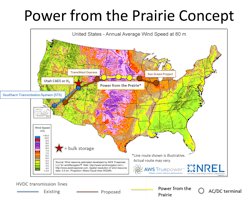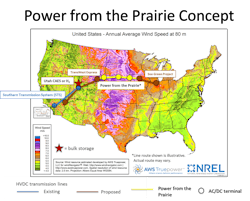Interregional Transmission in the Balance
Editor's Note: Robert Schulte will be presenting "Experiences with HVDC" at the T&D World Live Conference & Exhibition on Sept. 13, 2023. Check https://events.tdworld.com for more information.
There is a lot of excitement about energy infrastructure right now, including Interregional electric transmission.
- FERC addressing planning and federal/state coordination.
- Congress passed the infrastructure Bill and Inflation Reduction Act (IRA) and talking about improving siting and routing.
- DOE with lots of Infrastructure Bill and IRA monies to invest.
- How to untangle the current quagmire of clean energy interconnection requests.
But why is interregional transmission still not happening? Let’s get real.
About PftP
Power from the Prairie (PftP) is a proposed, 4,000 MW high-voltage direct current interregional transmission line. It would span the wind energy fields of Wyoming, crossing South Dakota or Nebraska, to the wind fields of Iowa. Unlike traditional DC lines that have only two HVDC (one at each end), PftP would have five, to enable interconnection of large quantities of new renewables in some of the best wind energy resources in the country, but currently landlocked due to lack of transmission and access to markets.
When combined with existing and proposed HVDC lines to its West and East, PftP would represent a renewable energy superhighway from the Pacific Coast to Chicago and Eastward. And unlike traditional HVDC lines that are usually unidirectional (wind to load), PftP would be bi-directional, enabling swaps of time-diversified renewable energy from one end to the other.
PftP LLC is an Iowa-based company created to facilitate change in how interregional transmission is done — to be productively disruptive to traditional industry approaches, which are largely ineffective. Like others, we are frustrated by the lack of progress in the topic. Not a transmission or renewables developer, we are an objective, neutral, and qualified coordinator of interregional transmission projects involving multiple participants.
We designed PftP to be a publicly visible pathfinder project of what it takes to accomplish interregional transmission, and to draw attention to the necessary solutions.
PftP LLC organized and led a PftP Concept Development Study (CDS) that was completed this April. The one-year, $800k study involved nine industry participants representing 14 utilities and developers. The project report is posted on our website (www.powerfromtheprairie.com/the-cds).
The CDS found the project can be cost-effective for public and private utilities. The 30% investment tax credit (ITC) on transmission now being considered in Congress (Heinrich) would have a significant benefit to the cost-effectiveness of the project. For an investor-owned utility, it could represent $330 million to $500 million in annual pre-tax equity earnings (this range represents with and without the ITC, respectively). It would enable 3,000 MW of additional renewables at its HVDC converters.
We are now recruiting participants f or Stage 2: Proof of Concept. What would it take to move things further?
The Main Challenge
Technology is not the issue. We already know how to do HVDC. No R&D would be required.
While the various federal and state efforts now underway are needed and helpful, the still-missing puzzle piece is pretty clear. A senior executive at a large Midwest utility said it best: “There are only three things blocking our participation in projects like PftP: 1) cost recovery, 2) cost recovery, and 3) cost recovery.”
Interregional projects are capital-intensive. For example, the HVDC parts of the 750-mile PftP line would cost about $7 billion. HVAC interconnections might be another $2 billion. And the uncertainty about how those costs would be recovered from ratepayers, regardless of the project’s cost-effectiveness, is the true barrier to making progress. The potential line owners will not invest the money unless they are reasonably assured they will get it back.
The Challenge: There Are No Rules
1. There is currently no interregional transmission planning process. While the Regional Transmission Organizations (RTOs) and planning regions have done some “interregional” planning, they have resulted in only relatively small projects along their immediate seams. In the CDS, PftP LLC had to create a coordinated planning model across their systems because the RTOs did not have one — particularly for crossing the seam between the Western and Eastern Interconnections as PftP would do.
FERC needs to put some teeth into the wishful thinking of Order 1000 that only suggested interregional planning would be a good idea.
2. There is currently no interregional cost recovery process. The PftP CDS found that the benefits of interregional transmission appear across multiple regions and are not centered on only the line owners themselves. This suggests that a Multi-Value Project (MVP) approach like is done in MISO (Midcontinent Independent System Operator), where costs are spread across the entire region that is benefitting, would be appropriate. But such approaches are not available consistently everywhere. And there is no process to coordinate such approaches and thereby allocate costs across multiple regions.
Again, we view that FERC has a role here too.
3. There is currently no regional cost recovery process in the West. Except for CAISO (California Independent System Operator), the Western Electricity Coordinating Council (WECC) is a planning region; not an RTO. It is made up of 36 individual Balancing Authorities (BA). Much of the value of PftP occurs in WECC. ‘How to go house-to-house to each BA to secure cost recovery for their individual share of the benefits? This appears to argue in favor of a Western-wide RTO that is currently under discussion.
4. The need for federal leadership. Finally, much of the current hesitation in doing interregional transmission relates to a need for someone to provide a Big Picture, non-Balkanized, responsible image of leadership for the states and individual utilities. This is necessary to resolve the above challenges, including the needs of states and sovereign tribes along the way. We believe U.S. Department of Energy (DOE) is in a good place to do this. And they can use PftP and similar projects as examples.
In the meantime, interregional transmission development will remain in-the-balance.
Robert H. Schulte is managing member at Power from the Prairie LLC.
About the Author
Robert H. Schulte
Robert H. Schulte is managing member at Power from the Prairie LLC.

